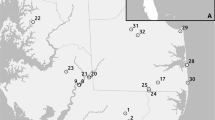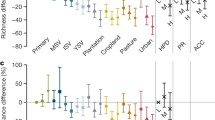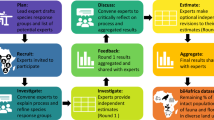Abstract
Estimates of minimum areas required for effective biodiversity conservation differ substantially. Scientific reserve design and placement procedures indicate that between 30 and 75% of any region may be required to sample biodiversity features. These estimates do not routinely incorporate measures for sampling viable populations of species or explore the area requirements of sampling viable populations of species assemblages. To determine the area requirements for sampling viable populations of a herbivore assemblage, spatially explicit abundance data from the Kruger National Park, South Africa, were analyzed. Area requirements were consistently above 50% and were unaffected by selected target population sizes. In addition, area requirements appeared to be insensitive to selection unit size (analytical grain), habitat quality, the coarseness of the land classification system used or the presence of low-density species. Thus, traditional conservation area targets of 10–15% appear inadequate for representing viable populations of a herbivore assemblage from African savanna regions. This suggests that conservation targets of at least 50% of land classification units may represent a more appropriate conservation rule of thumb, or alternatively, that the use of data independent conservation targets may need to be abandoned.
Similar content being viewed by others
References
Caughley G. and Sinclair A.R.E. 1994. Wildlife Ecology and Management. Blackwell Science, Cam-bridge, UK.
Eiselen R. 1994. Estimating the trends in herbivore numbers in the Southern District of the Kruger National Park. South African Journal of Wildlife Research 24: 95-100.
Fairbanks D.H.K., Reyers B. and van Jaarsveld A.S. 2001. Species and environment representation: selecting reserves for the retention of avian diversity in KwaZulu-Natal, South Africa. Biological Conservation 98: 365-379.
Gaston K.J. 1994. Rarity. Chapman & Hall, London.
Gertenbach W.P.D. 1983. Landscapes of the Kruger National Park. Koedoe 26: 9-121.
Howard P.C., Viskanic P., Davenport T.R.B., Kigenyi F.W., Baltzer M., Dickinson C.J. et al. 1998. Complementarity and the use of indicator groups for reserve selection in Uganda. Nature 394: 472-475
IUCN 1993. IUCN Bulletin 43, 10. World Conservation Union, Gland, Switzerland.
Joubert S.C.J. 1983. A monitoring programme for an extensive national park. In: Owen-Smith N. (ed.), Management of Large Mammals in African Conservation Areas. Haum, Pretoria, South Africa, pp. 201-212.
Low A.B. and Rebelo A.G. 1996. Vegetation of South Africa, Lesotho and Swaziland. Department of Environmental Affairs and Tourism, Pretoria, South Africa.
MacArthur R.H. and Wilson E.O. 1967. The Theory of Island Biogeography. Princeton University Press, Princeton, New Jersey.
Maddock A. and du Plessis M. 1999. Can species data only be appropriately used to conserve biodiversity. Biodiversity and Conservation 8: 603-615.
Margules C.R. and Pressey R.L. 2000. Systematic conservation planning. Nature 405: 243-253.
Margules C.R., Higgs A.J. and Rafe R.W. 1982. Modern biogeographical theory: are there any lessons for nature reserve design? Biological Conservation 24: 115-128.
McNeely J.A. and Miller K.R. 1983. National Parks and Protected Areas. UN Economic and Social Commission for Asia and the Pacific, Bangkok, Thailand.
Nicholls A.O. 1998. Integrating population abundance, dynamics and distribution into broad-scale priority setting. In: Mace G.M., Balmford A. and Ginsberg J.R. (eds), Conservation in a Changing World: Integrating Processes into Priority for Action. Cambridge University Press, Cambridge, UK, pp. 251-272.
Nicholls A.O., Viljoen P.C., Knight M.H. and van Jaarsveld A.S. 1996. Evaluating population persistence of censussed and unmanaged herbivore populations from the Kruger National Park, South Africa. Biological Conservation 76: 57-67.
Pressey R.L., Ferrier S., Hager T.C., Woods C.A., Tully S.L. and Weinman K.M. 1996. How well protected are the forests of north-eastern New South Wales?-Analyses of forest environments in relation to formal protection measures. Forest Ecology and Management 85: 311-333.
Pressey R.L., Humphries C.J., Margules C.R., Vane-Wright R.I. and Williams P.H. 1993. Beyond opportunism, key principles for systematic reserve selection. Trends in Ecology and Evolution 8: 124-128.
Reyers B. 2001. A multicriteria assessment of regional sustainability options in the northern province, South Africa, Ph.D. Thesis, University of Pretoria, South Africa.
Soule M.E. 1987. Viable Populations for Conservation. Cambridge University Press, Cambridge, UK.
Soule M.E. and Sanjayan M.A. 1998. Conservation targets: do they help? Science 279: 2060-2061.
van Jaarsveld A.S. 1995. Where to with reserve selection and conservation planning in South Africa. South African Journal of Zoology 30: 164-168.
van Jaarsveld A.S., Freitag S., Chown S.L., Muller C., Koch S., Hull H. et al. 1998a. Biodiversity assessment and conservation strategies. Science 279: 2106-2108.
van Jaarsveld A.S., Gaston K.J., Chown S.L. and Freitag S. 1998b. Throwing the biodiversity out with the binary data? South African Journal of Science 94: 210-214.
Venter F.J. 1990. A classification of land for management planning in the Kruger National Park, Ph.D. Thesis, University of South Africa, Pretoria, South Africa.
Viljoen P.C. and Retief P.F. 1994. The use of the global positioning system for real-time data collecting during ecological aerial surveys in the Kruger National Park. Koedoe 37: 149-157.
Williams P.H. 1998. Key sites for conservation: area selection models for biodiversity. In: Mace G.M., Balmford A. and Ginsberg J.R. (eds), Conservation in a Changing World: Integrating Processes into Priority for Action. Cambridge University Press, Cambridge, UK, pp. 211-249.
Williams P.H., Gibbons D., Margules C., Rebelo A., Humphries C. and Pressey R. 1996. A comparison of richness hot spots, rarity hot spots, and complementary areas for conserving diversity of British birds. Conservation Biology 10: 155-174.
World Commission on Environment and Development 1987. Our Common Future. Oxford University Press, Oxford, UK.
World Resources Institute 1994. World Resources, 1994-1995. Oxford University Press, New York.
Zambatis N. and Biggs H.C. 1995. Rainfall and temperatures during the 1991/ 92 drought in the Kruger National Park. Koedoe 38: 1-16.
Author information
Authors and Affiliations
Corresponding author
Rights and permissions
About this article
Cite this article
Solomon, M., Van Jaarsveld, A.S., Biggs, H.C. et al. Conservation targets for viable species assemblages?. Biodiversity and Conservation 12, 2435–2441 (2003). https://doi.org/10.1023/A:1025805731366
Issue Date:
DOI: https://doi.org/10.1023/A:1025805731366




